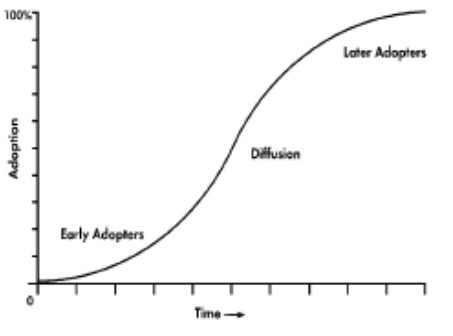Diffusion of Innovation
D and/or I:
 The focus on dissemination and/or implementation activities. D-only focuses on an active approach of spreading evidence-based interventions to target audience via determined channels using planned strategies. D=I, D>I, and I>D means there is some focus on both dissemination and implementation. I-only focuses on process of putting to use or integrating evidence-based interventions within a setting.
The focus on dissemination and/or implementation activities. D-only focuses on an active approach of spreading evidence-based interventions to target audience via determined channels using planned strategies. D=I, D>I, and I>D means there is some focus on both dissemination and implementation. I-only focuses on process of putting to use or integrating evidence-based interventions within a setting.
D-Only Socio-Ecological Levels:
 The level of the framework at which the model operates. Individual includes personal characteristics; Organization includes hospitals, service organizations, and factories; Community includes local government and neighborhoods; System includes hospital systems and government; Policy includes changes in policy.
The level of the framework at which the model operates. Individual includes personal characteristics; Organization includes hospitals, service organizations, and factories; Community includes local government and neighborhoods; System includes hospital systems and government; Policy includes changes in policy.
- Individual
- Organization
- Community
Number of Times Cited:
 The # of times the original publication for the model was cited as indicated by Google Scholar since 2016.
The # of times the original publication for the model was cited as indicated by Google Scholar since 2016.
19700 Field of Origin:
 The field of study in which the model originated.
The field of study in which the model originated.
Agriculture Practitioner/Researcher:
 Whether the model is for the use of practitioners and/or researchers.
Whether the model is for the use of practitioners and/or researchers.
Researcher and Practitioner Rating:
 These are ratings given by users of the site.
These are ratings given by users of the site.
Constructs:
 Name of the construct developed by classifying/aligning the elements abstracted from models.
Name of the construct developed by classifying/aligning the elements abstracted from models.
Assessment Instruments:
 Name of the assessment developed by classifying/aligning the elements abstracted from models.
Name of the assessment developed by classifying/aligning the elements abstracted from models.
- Consolidated Framework for Implementation Research (CFIR) Interview Guide Webtool
- Dissemination and Implementation Research Capability Self-Survey (DIRC-SS)
- Implementation Climate Scale (ICS)
- Intervention Determinants Item Banks (IDIB)
- Inventory of Factors Affecting Successful Implementation and Sustainment (IFASIS)
- Iterative, Practical, Robust Implementation and Sustainability Model (iPRISM) Webtool
- Knowledge Exchange Outcomes Tool
- Normalization Process Theory Interview Guide
- Rapid Assessment Procedure Informed Clinical Ethnography (RAPICE) Protocol, Activity, and Interview Prompt Guide
- Rapid Assessment Procedure Informed Clinical Ethnography (RAPICE) Summary Template
- Readiness Thinking Tool - Observation Guide
- Readiness Thinking Tool - Survey
- Readiness for Recovery and Resiliency - Interview Guide
- Van Schaik's Technology Acceptance Model (TAM)
Citations:
 The original publication(s) of the model.
The original publication(s) of the model.
Rogers EM. Diffusion of innovations. 5th ed. New York: Free Press, 2003. Examples:
 Citations of studies that have used the model as an outline for their study.
Citations of studies that have used the model as an outline for their study.
Al-Ghaith WA, Sanzogni L, Sandhu K. Factors influencing the adoption and usage of online services in Saudi Arabia. Electronic J Info Syst Developing Countries 2010;40(1):1-32.Ball K. Compliance with surgical smoke evacuation guidelines: implications for practice. AORN J 2010;92(2):142-9.
Ball K. Surgical smoke evacuation guidelines: compliance among perioperative nurses. AORN J 2010;92(2):e1-e23.
Dingfelder HE, Mandell DS. Bridging the research-to-practice gap in autism intervention: an application of diffusion of innovation theory. J Autism Dev Disord 2011;41(5):597-609.
Glanz K, Steffen A, Elliott T, O’Riordan D. Diffusion of an effective skin cancer prevention program: design, theoretical foundations, and first-year implementation. Health Psychol 2005;24(5):477-87.
Nanney MS, Haire-Joshu D, Brownson RC, Kostelc J, Stephen M, Elliott M. Awareness and adoption of a nationally disseminated dietary curriculum. Am Journal Health Behav 2007;31(1):64-73.
Shively M, Riegel B, Waterhouse D, Burns D, Templin K, Thomason T. Testing a community level research utilization intervention. Appl Nurs Res 1997;10(3):121-7.
Wiecha JL, El Ayadi AM, Fuemmeler BF, et al. Diffusion of an integrated health education program in an urban school system: planet health. J Pediatr Psychol 2004;29(6):467-74.
There are no reviews yet. Be the first one to write one.
